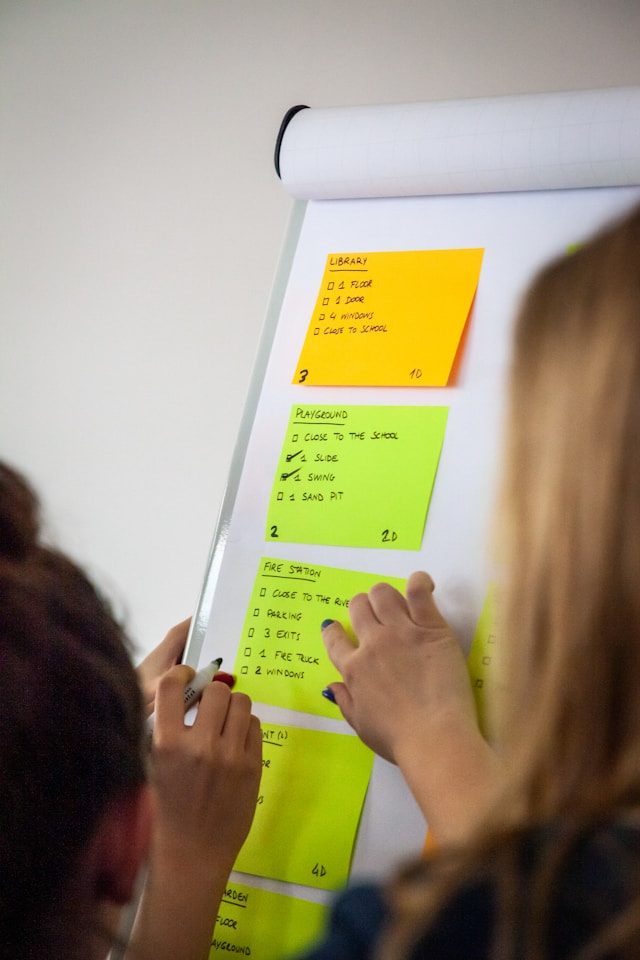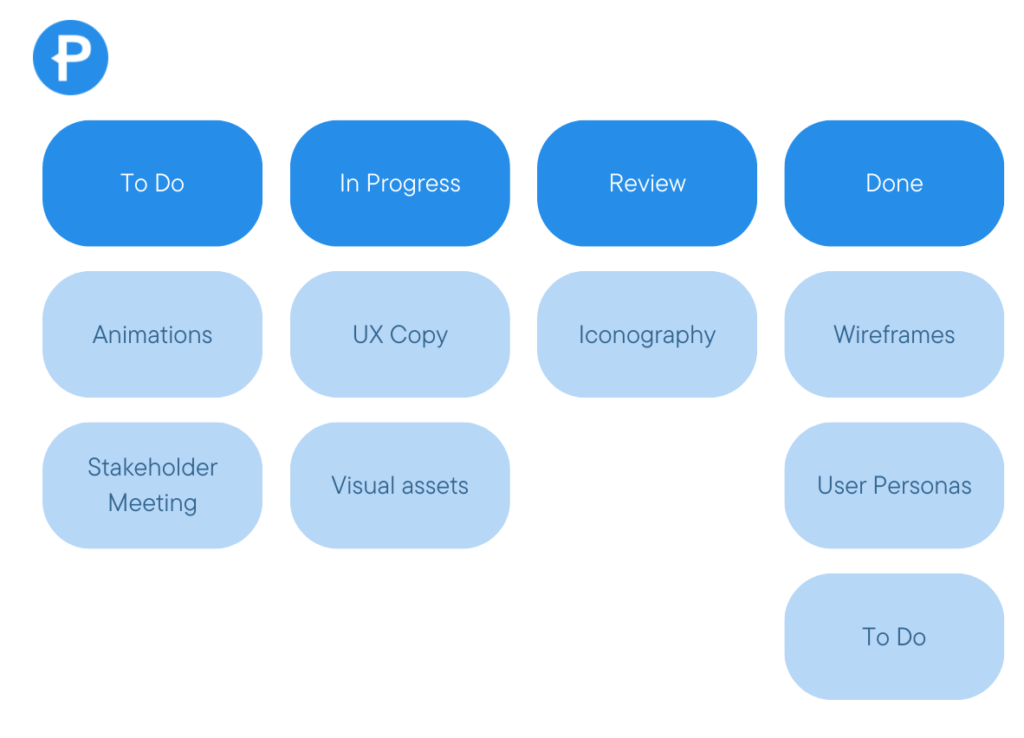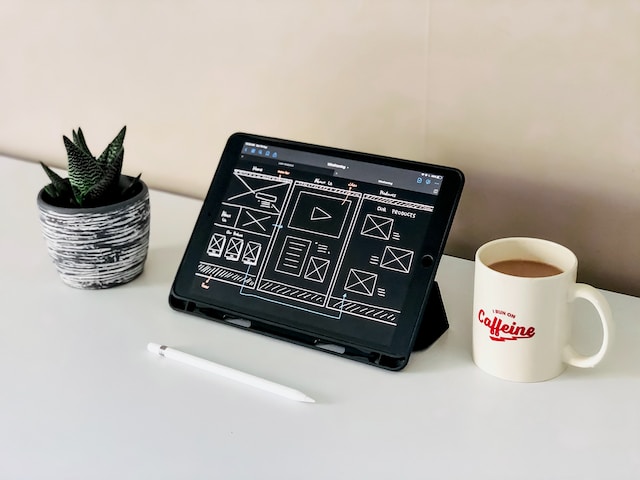Agile project management is all about providing a way for teams to visualize their tasks and manage workflows. There are tons of techniques available, two of which are kanban boards and scrums. When it comes to choosing between kanban vs. scrum, the answer depends on what you’re looking for.
Each method has its pros and cons for UX design. So, here’s everything you need to know about both so you can decide which is best for your team.

What Is a Kanban?
A kanban board is a visual project management system. It uses cards to represent each task. These cards exist on a board that captures the project as a whole. As a result, you have a visual overflow of the whole workflow. As you move through the tasks, they move across the board to show their status.
Developed in the 1940s in Japan by Taiichi Ohno, the kanban method helps teams control their output at all stages. Project managers can always see what their team is up to, thanks to the cards appearing in different columns.
Typically, these columns are the following workflow stages:
- To Do
- In Progress
- Review
- Done
However, teams can add columns specific to their workflows or for their unique project needs. This includes ‘paused,’ ‘archived,’ or ‘urgent.’
Key concepts involved in the kanban technique are:
- Definition of Workflow (DoW): The DoW defines what units are moving across the board. It considers what terms like ‘started’ and ‘finished’ mean and how long it should take to complete a task.
- Work in Progress (WIP) limits: With Kanban, teams can set WIP limits. As a result, the team can’t be working on more than a certain number of things at once. This helps to prevent bottlenecks and speed up the process.
- Kaizen: Meaning “continuous improvement” in Japanese, kaizen encourages the team to always work better. The kaizen mindset is a driving force behind the kanban method.
Typically, you can measure the success of the project by gauging lead time and cycle time. How long it takes for a task to move from ‘To Do’ to ‘Completed’ is a key metric here.
What Is a Scrum?
The Scrum method also originates from Japan. Developed by Hirotaka Takeuchi and Ikujiro Nonaka in 1986, this is another agile project management method. As a newer method than kanban, scrum is still evolving. Scrum teams are always finding new ways to use this tool.
Essentially, Scrum is an agile framework that allows teams to use strict periods for specific tasks. The method breaks this down into several concepts:
- Sprints
- Roles
- Artifacts
- Timeboxing
- Collaboration
- Constant improvement
The scrum framework also involves three distinct roles:
- Product owner
- Development team
- Scrum master
So, within the scrum, each role works on a small section of the larger project. At the start of each sprint, the development team plants the scrum timeline. Then, the scrum master breaks the sprint down into small tasks and supervises their progress. The scrum master also estimates how much time it will take to complete the sprint. Everybody should agree on the sprint’s length ahead of time.
If priorities change during the spring, the entire sprint stops. Then, the sprint planning process begins again.
How Does Scrum Work in Practice?
Generally, ‘sprints’ can last from a day up to four weeks. This depends on the scope of the project. These fast, uninterrupted periods try to boost productivity. Within these sprints, the team breaks up complex tasks into smaller ones.
This includes the sprint planning, sprint review, and sprint retrospectives. Each day, the team meets to go over daily to-dos, quick wins, and current roadblocks. Even despite these daily meetings, scrums are less flexible than kanbans.
As a project management methodology, scrum rests on three pillars:
- Adaptation: Scrum can accommodate a project that changes tactical direction.
- Transparency: Everybody knows what’s going on during the project and why.
- Inspection: Team members can inspect the project throughout. This fosters improvement.
To visualize the project throughout, teams use a scrum board. This usually involves three columns: To Do, In Progress, and Done. However, some teams use more complex boards with more sections.

The Difference Between Scrum and Kanban
By now, you may have noticed some key differences between scrums and kanbans. Both are agile planning methods. However, kanban is all about visualizing tasks, while Scrum is about fostering team culture and enhancing productivity. Kanbans deliver work continuously, while scrums work to tight deadlines.
At their core, the difference between scrum and kanban is quite stark. Here’s a helpful table to visualize the difference between scrum vs. kanban.
| Kanban | Scrum | |
| Roles | No roles | Scrum master, product owner, development team |
| Delivery cycle | Continuous | Sprint cycle lasting 1-4 weeks |
| Change policy | Change can occur at any time | Change cannot occur during the sprint |
| Artifacts | Kanban board | Product backlog, sprint backlog, product increments |
| Key concepts | Effective, efficient, predictable | Transparent, adaptable, inspection |
| Key metrics | Cycle times and lead times | Velocity |
| Collaborative nature | Yes | Yes |
| What it looks like | A task-based board to show workflow | Focused sprints that involve working on specific tasks |
| Who it’s for | Teams working on ongoing projects | Short projects with chronological, complex tasks |
Reviewing this table might help you decide on a method, but a cross-functional team may use both for different purposes.
There are, of course, pros and cons of each method. Let’s explore these in more detail.
Kanban Pros
Kanban boards are great for continuous projects with repetitive tasks. Here’s how they help.
- Help you visualize the workflow.
- Ensure you can plan upcoming work.
- Can change at any time.
- Ensures quality with WIP limits.
- Prevents bottlenecks and manages workflow.
- Establishes a feedback loop.
- Improves team collaboration.
Kanban Cons
There are still limitations to using Kanban boards. Here are some of the drawbacks.
- With no strict responsibilities, the teams cannot prioritize among themselves.
- There are no timing parameters.
- Depending on the project, the board can become complex and confusing.
Scrum Pros
The scrum method also has several advantages, particularly for complex projects.
- Ensures team members can focus on specific tasks and increase productivity.
- Achieves quick wins that drive team motivation.
- Divides complex projects into more actionable activities.
- Provides transparency for product owners and stakeholders.
- Creates a goal-oriented workflow.
Scrum Cons
There are drawbacks to the scrum method, and it doesn’t work for everyone.
- With slower team members, it can lead to pacing issues.
- It’s not flexible when priorities change mid-sprint.
- Demands a lot of resources for planning and tracking.
- Requires a lot of focus.

When To Use Kanban vs. Scrum?
The differences between the two methods mean that development teams can use them in different situations. Here’s when to use kanban vs. scrum.
The kanban method works in almost any situation. However, it’s more useful for projects with a continuous flow of tasks. If your team has incoming requests at any given time, then a kanban is likely an effective solution. Your team can always take on new assignments, and project managers can see who’s doing what.
Meanwhile, teams that are working on a similar project all at the same time can use Scrum. With this method, everybody works on the same thing even though they have a specific role. Since it’s less flexible than Kanban, scrum is better for chronological tasks. As a result, many software development teams favor it for its ability to enhance productivity and focus the team.
Wait, There’s More: Agile vs. Scrum vs. Kanban
If deciding between Kanban vs. Scrum board wasn’t enough, there are even more methods to consider. You might have already heard the term ‘agile.’ Agile refers to a broad set of project management principles that encourage an adaptive way to work.
So, what’s the difference between agile vs. scrum vs. kanban? Technically, scrum and kanban are two types of agile techniques. There are also others, such as Lean (LN) and the Dynamic System Development Model. Kanban and Scrum are two of the most popular.
According to Radixweb, 61% of companies use Agile for software development. 66% use scrum, and 6% use kanban. The rest employ other techniques.
Any cross-functional team that works on frequently changing projects can make use of agile project management. These methods all include the ability to adapt to change and a way to foster transparency across the team. As a result, they’re ideal for a huge range of projects.

The Main Difference Between Agile and Scrum
Nevertheless, some people get confused between the different methods. The primary difference between agile and scrum is that ‘agile’ refers to a style of project management. Meanwhile, scrum is a specific technique within this umbrella.
Kanban is also a technique within agile project management. So, while agile refers to the approach, kanban and scrum are the specific methodologies.
What About Kanban vs. Sprint?
By now, you probably understand the way kanban boards work and how they differ from scrum. However, is a kanban or a scrum better for your team? Deciding this requires an understanding of Kanban vs. Sprint.
Kanbans are great for workflow. The progress of a task may be slow, but it’s continuous, giving the project manager full oversight. Ideally, kanban should lead to a gradual decrease in lead times for tasks. However, crucially, this technique is not time-bound. The goal is always to keep work flowing and prevent bottlenecks. Although there may be deadlines, they are not always strict.
Sprints, on the other hand, are always time-boxed tasks. Their goal is to produce deliverables in a shorter time space, enhancing focus on a specific task. As a result, they require more focus and greater collaboration.
Understanding this difference can help you choose the right method. If you need to improve workflow, choose Kanban. If you’re in a time crunch, choose scrum.

Kanban Methodology: How To Use It for UX?
Now that you understand a scrum board vs. a kanban board, you might be wondering how to use them for UX. Scrums are a little more obvious since a lot of development requires the team to focus on one thing.
Here’s how the Kanban methodology can work for UX.
- The project manager creates a to-do list for each item of the project.
- They assign each task to a team member.
- As the team member starts a task, they move it to the ‘In Progress’ column. That way, the manager has a full overview of what’s happening.
- When they complete the task, they move it to ‘Review.’
- The project manager reviews the task and then moves it to ‘Done.’
In this way, you might have wireframes in the ‘Done’ column while the iconography is still in review. The UX copy could still be in progress during this time.

Need More UX Ideas? Check Out Page Flows
Hopefully, this guide gave you a better insight into kanban vs. scrum. Knowing which technique to use can greatly improve your team’s productivity and workflow.
That said, project management is just one aspect of great UX. You still need to employ best practices.
If you’re looking for design inspiration to enhance your process, why not learn from proven products? Page Flows is a helpful resource for finding design ideas. Get started today to access our growing library of user flow recordings and finally stay up-to-date with current design trends.





